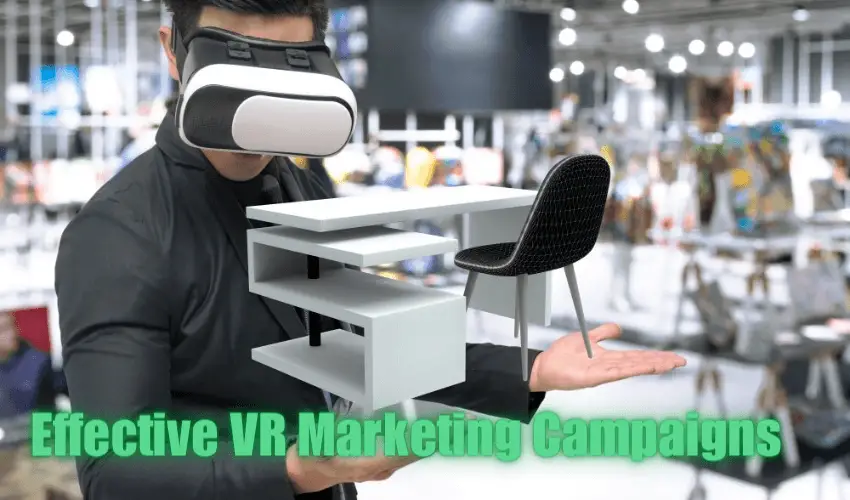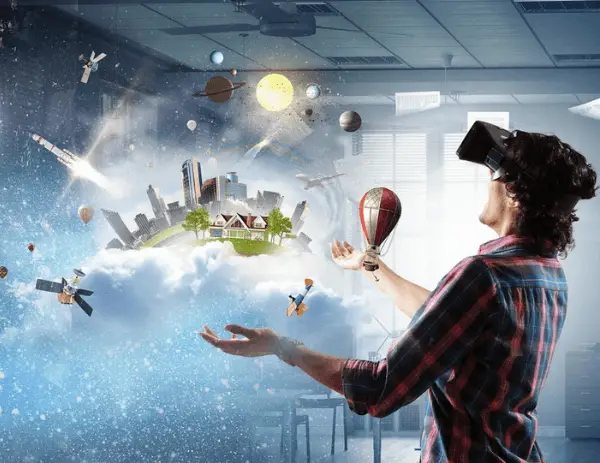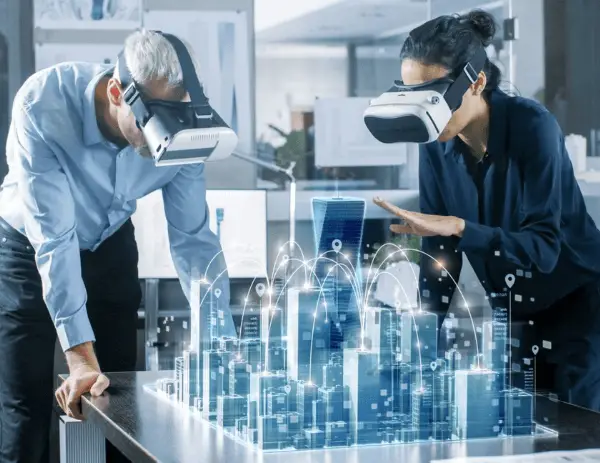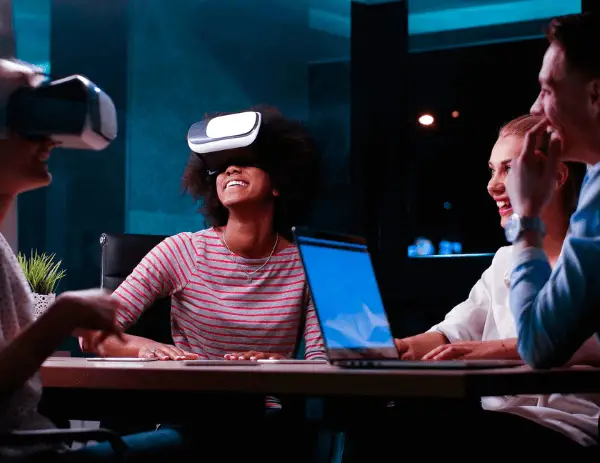
Marketing techniques come in many kinds and sizes, but they all have one thing in common: the desire to capture people’s attention and offer them something they’ve never seen before.
Technology plays an important part here, as it not only aids in creating material for marketing campaigns but also in its delivery to users. VR is the ideal platform for this purpose.
Don’t worry if you’ve never explored the realm of virtual reality (VR); you will undoubtedly get the opportunity soon. The world’s largest firms have incorporated VR into their marketing strategy, and that’s no surprise, given how effective it is as a marketing tool.
It’s strong in the most apparent sense since it enables us to become closer and more intimate with specific items. But, from an advertising standpoint, there’s a lot to be said about increasing consumer awareness, speeding up the purchase process, and providing more tailored options to customers.
Below, we’ll go through the fundamentals of virtual reality (VR) and discuss some of the most innovative advertising methods that corporations have lately employed using this new technology.
What Is Virtual Reality?

Virtual reality, or VR, is a technologically generated environment delivered to humans via their senses like sight, hearing, contact, and others. It replicates exposure as well as reactions to exposure and creates a virtual representation or atmosphere that simulates reality.
VR technology was previously only connected with the gaming sector. Today, however, several industries are adapting to unique kinds of VR to achieve better outcomes for their commercial objectives.
Aside from gaming and socializing, interactive VR aims to increase collaboration among people from diverse businesses. The growth of Web3 and the capacity of VR to generate new options for users are the reasons for such quick adoption.
How Does Virtual Reality Work?
In the near future, you’ll hear the phrases virtual reality, augmented reality, and mixed reality tossed about a lot more. Let’s break them down.
1. Virtual Reality
Virtual reality is a broad word for any experience that immerses the user “in” a different world or dimension. It can refer to fully digital worlds or ones that combine real and virtual elements.
2. Augmented Reality
This is a word for putting stuff “into” the actual world, for example, by utilizing your iPhone’s camera. The most well-known example is Pokémon Go.
3. Mixed Reality
Mixed reality is a blend of actual and digital material that can include, for example, two video sources placed on top of each other. In this example, virtual and physical objects interact with one another.
What Is VR Marketing And Why Is It Important?

VR marketing is a marketing strategy that uses virtual reality software in campaigns to provide its audience with a 3D 360° immersive environment. This might be a banner advertisement within a virtual environment or a tech demo that lets customers check out things before purchasing them.
VR marketers intend to exploit this growing technology in novel and innovative ways to boost their products and services. In fact, when a company delivers a VR experience consumers become more involved. VR enables you to interact with customers in ways never previously possible by providing more engaging and meaningful experiences.
Benefits And Challenges Of VR Marketing
Benefits Of VR Marketing
1. Campaigns Are Simple To Implement
To provide an immersive experience to someone, all you truly need is software and a headset. This is whenever we discuss in-person access to events, business facilities, etc. You may also make the application accessible online for current VR users to install and experiment with remotely.
2. Improves The Interaction Between A Customer And A Product
Handling anything in VR is a terrific way to comprehend how it works. Interactive software is as good as physical items in teaching your customers about what you offer. Furthermore, by making the experience enjoyable and fascinating, you may create an emotional tie between the consumer and the product.
3. Users And Clients Are Impressed
VR is a dazzling technology that makes an impact. People are often eager to try new technologies and generally enter an immersive environment with high hopes. This makes it simple to captivate them and stamp your product/service in their minds.
4. Sales Teams’ Workload Is Reduced
Aside from displaying a product or service, VR may also be used as a sales tool, allowing customers to swiftly transition from inspecting and understanding a product to buying it. This rewarding and realistic experience significantly minimizes the number of inquiries directed to sales representatives.
Challenges Of VR Marketing
1. It Is Difficult To Generate Common Experiences
Because generating shared experiences takes far longer and is more difficult to pull off, most VR apps are designed to be used by one person at a time. This problem may be solved by developing multi-user programs that can be accessible by anybody having a headset, either locally or remotely.
2. Individual Development Requirements
VR software development remains relatively new, and most businesses need to employ developers familiar with the technology. As a result, they must recruit professionals or collaborate with a skilled production company for the length of the project.
The Future Of Virtual Reality In Marketing

VR appears to have a promising future in this industry for several reasons. To begin with, VR headset usage is rapidly increasing, with sales expected to grow significantly. Furthermore, when organizations of all sizes develop their own metaverses’ based on immersive technology, the need for VR experiences will increase.
Finally, we should look at trendsetters, large brands, and organizations adopting VR marketing and leading the path for smaller businesses to follow suit. After all, nobody likes to be left behind or lose momentum to competitors.
How Can You Use Virtual Reality In Marketing?
The apps that enable immersive experiences may be designed for a wide range of applications and various VR target markets. VR may be used in B2B marketing, for example. Let’s dive into the specifics, with the most popular use of VR in marketing being:
1. VR Advertising
Although virtual reality advertisements are not widespread, companies like Oculus are currently testing how they may be applied. You may still contribute VR-branded content and personalized advertising to your immersive app unless a platform-wide ad system is established.
2. Showroom And Simulation
The most frequent use is an experience that lets users see a product, item, or place up close (and from various perspectives), interact with it, and occasionally edit it (product configurators).
3. Market Research
This is a form of indirect use, as most VR apps do not collect user information as their primary goal. Nonetheless, the actions and decisions taken by users in these applications may be easily traced and they give important information about the clientele of a business.
4. Branded Games
Branded games may be a great method to raise brand recognition and familiarize clients with your products pleasantly and stress-freely. Users have been subjected to content advertising a brand and its products as they focus on gaming.
5. Content Marketing
VR in content marketing is useful since it is one of the greatest visualization tools available. 3D models, graphics, animation, and even words become considerably more entertaining and intelligible when presented in a headset.
6. Virtual Meets
This is a practical approach in our contemporary world of social alienation. Virtual events have become widespread, with users from all over the world capable of putting on a headset, walking about a digital event hall, observing speakers and demonstrations, and communicating with others (via their avatars).
9 Effective VR Marketing Campaigns
Today, virtual reality has become an essential component of many sectors. Marketers are experimenting with new applications as more people and businesses embrace this technology. That said, here are a few of the most effective virtual reality marketing campaigns set up by some of the most reputed brand names.
1. Deliver A Story – New York Times
VR tech was pretty new in 2016, which is when the New York Times partnered with Google to introduce the world to this emerging technology through Google Cardboard. Anyone with an online subscription received a Google Cardboard – a VR box that had to be built to experience VR through a phone.
New York Times intended the subscribers to watch “Seeking Pluto’s Frigid Heart” – a VR film that gives you a closer look into the dwarf planet.
2. Technology At Its Best – VERYX
VR helped show what the latest technology is capable of at the food packaging trade show at Pack Expo. The VR demo on VERYX. It showed the exact process of the food sorting operation.
3. VR Departmental Store – eBay And Myer
Make your business stand out by displaying items that have the appropriate VR implementations. eBay and Myer, an Australian retailer, have established the world’s first Virtual Reality Department Store. The store displayed three-dimensional replicas of hundreds of the most popular goods in each category.
Everyone may thoroughly study the merchandise before purchasing it without going into the store. To that end, the business created the eBay Sight Search technology. The user chooses items and places them in the basket in the line of their eyes.
4. Delicatessen – Adidas
Businesses may create a solo marketing campaign using VR technology. Brands may also use VR to showcase their upcoming items. Adidas has collaborated with the latest technological marketing firm, Somewhere Else, to monitor the climbing trip of two TERREX-sponsored extreme sportsmen (a division of Adidas).
Viewers may also follow climbers Ben Rueck and Delaney Miller upward by wearing a VR headset and holding two touchpad remote controls in each hand.
5. Tom’s VR Marketing Campaign
You must have heard of Toms charity campaigns where a customer buying a pair of shoes would also be essentially donating a pair to an underprivileged child. As such, “Toms Virtual Giving Trip” presented a virtual reality experience of going on a trip to Peru.
The entire virtual tour experience was narrated by Blake Mycoskie and customers got to feel the joy of the children getting their first pair of shoes.
6. Sell Cheese – Boursin Sensorium
Boursin Sensorium, a food firm, walked around shopping malls giving consumers a feel of this VR experience. Customers’ senses were engaged by graphics, music, cold air, fans, a rotating chair, and product samples.
7. The Migraine Experience – GSK
As an educational campaign, GSK came forward with the “Exedrin Migraine Experience.” People who’ve never experienced a migraine can get a better understanding of this condition with this VR simulation. Of course, you don’t get to feel the pain, but you’ll experience visual symptoms like light sensitivity and auras.
8. Happy Goggles – McDonald’s
The goal of this VR campaign was to teach children the importance of recycling using virtual reality technology. McDonald’s converted its Happy Meal Box into a Google Cardboard headset. And children had to assemble it to access “Slope Stars” – an educational game.
9. Catwalk VR – TopShop
This campaign was for those individuals who wanted to attend the TopShop’s fashion show during the London Fashion Week but were unable to do so. They could get a seat next to the runway in the virtual world instead!
Final Words – How Is Virtual Reality Changing The Sphere Of Marketing?
When utilized to improve marketing techniques, virtual reality may leave a lasting effect on its consumers and your clients. Since VR users may install or use your VR features remotely, you’d generate additional options for greater emotional involvement and construct campaigns that are simple to implement.
Furthermore, VR can boost sales teams’ productivity by reducing their burden. Companies may use VR to exhibit their services or products without needing a sales assistant to watch clients constantly.
However, because VR is still a comparatively recent technology, employing it for marketing presents certain obstacles. Developers and organizations unfamiliar with the technology may need help to traverse VR software development to construct one-of-a-kind marketing campaigns.
Despite these obstacles, VR has proven to be an effective marketing tool. It may be used in B2B marketing, for example, to develop more engaging content, arrange virtual events such as trade exhibits, and conduct market research.
Aside from these features, marketers can utilize VR to develop branded content, enable customers to virtually try products, improve customer service, and showcase the beneficial effect of their brand activities.

